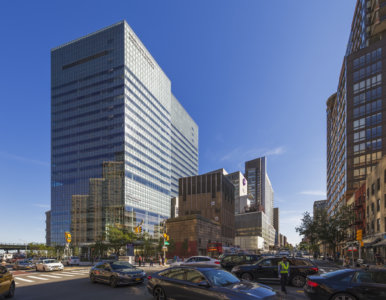A Passion for Healthcare Architecture: Bryan Langlands (MArch’92)
 Bryan Langlands (MArch ’92) is a Principal at NBBJ New York. NBBJ is a leading architecture and design firm dedicated to improving the way society heals, works and thrives. NBBJ was recognized by Fast Company magazine in 2018 as the “Most Innovative Architecture Firm in the World”. Bryan, an accomplished healthcare programmer, planner and designer of academic medical centers, specialty centers and community hospitals, has been named one of the “HCD10”, Healthcare Design magazine annual awards. He was awarded Team MVP for his work with others on the FGI guidelines, and the emergency department alternative treatment space.
Bryan Langlands (MArch ’92) is a Principal at NBBJ New York. NBBJ is a leading architecture and design firm dedicated to improving the way society heals, works and thrives. NBBJ was recognized by Fast Company magazine in 2018 as the “Most Innovative Architecture Firm in the World”. Bryan, an accomplished healthcare programmer, planner and designer of academic medical centers, specialty centers and community hospitals, has been named one of the “HCD10”, Healthcare Design magazine annual awards. He was awarded Team MVP for his work with others on the FGI guidelines, and the emergency department alternative treatment space.
Education and Early Career
Bryan graduated with a BEDS in ’91, and MArch in ’92 and received the Henry Adams Medallion for his thesis project. His thesis was focused on developing a new home for NSCAD. He was employed by Zaha Hadid Architecture in London, and Morphosis in Los Angeles during his coop work terms.
After graduation Bryan moved to Vancouver where he worked with Nick Milkovich Architects and Arthur Erickson Architectural Corporation. He enjoyed his time there and learned a lot, working on private residences with NMA and some master planning projects with AEAC, but something was missing.
Artistic Education

NYU Langone Medical Center, Location: New York, New York, Architect: NBBJ/ Ennead
Bryan decided to veer away from architecture and applied to the Emily Carr Institute of Art and Design to explore a more tactile artistic expression. He graduated with a BFA in Sculpture in ’96. Nearing graduation, Bryan knew he wanted to be a professional artist, and to be in the United States so he applied to graduate school and decided to pursue a MFA in Combined Media at Hunter College at the City University of New York. He moved to NYC the summer of ’96, and began classes in August of that year. He was fascinated by New York! Bryan recalls “I remember walking through the streets of NY the first few weeks and thinking to myself two things – I felt that everything I have done so far in my life was in preparation for being here in NY, and why did it take so long for me to get here!”
Bryan’s art work was topic focused, typically with a theme addressing “isms”. Racism, sexism, homophobia. The work itself was sculptural and installation-based, with many being more ready-made objects and additive in nature – probably attributed to his architectural education and experience. During his time at Hunter, in order to supplement his income and offset education costs, he decided to work, however with the student visa that he was on, was only allowed to work in a field that was associated with his education.
For a while he was a gallery assistant, and “preparater” assisting the installation of shows, and also a teaching and art assistant to artist Valerie Jaudon. After his first year, Bryan decided to take three years, instead of two, to extend his degree, and to work full time while going to school. At this time he returned to architecture by working at SITE Architecture. Following a short time there, he ended up at Davis Brody Bond working closely with an architect and later, mentor – Donald Blair.
Return to Architectural Practice
In early ’98, Donald Blair opened his own firm and Bryan went with him. With Donald’s previous experience working with academic medical centers, and his continued relationship with them, it was here that Bryan became involved with architecture and healthcare. Over the course of 12 years, he slowly became knowledgeable about healthcare architecture working on hospitals, cancer centers, research buildings and the like.

NYU Langone Medical Center, Location: New York, New York, Architect: NBBJ/Ennead
In 2010 Bryan joined NBBJ where he is currently a principal, and one of the leaders of the healthcare practice for the New York studio. NBBJ was recognized by Fast Company magazine in 2018 as the “Most Innovative Architecture Firm in the World”. He has been fortunate enough to work on some incredible projects at many of the top academic medical centers and healthcare systems in the United States including NYU Langone Health, Mt. Sinai, PennMed, Geisinger, Children’s Hospital of Philadelphia, Jefferson Health, University of Rochester Medical Center, and Vanderbilt University Medical Center.
A Passion for Healthcare Architecture
Before his introduction into healthcare architecture and design in ‘98, Bryan did not know such a field of expertise existed. From his first healthcare project, which was a modest renovation of a nursing unit for Columbia Memorial Hospital in Hudson NY, he was hooked.
Bryan enjoys the complexity of the work, the many factors which need to be considered, the heavy hand of regulatory requirements and authorities having jurisdiction. That’s the technical, work fulfilment side.

NYU Langone Medical Center, Location: New York, New York, Architect: NBBJ/Ennead
The emotional side is the impact that a designer and planner can have on healthcare spaces and the well-being for staff, patients and visitors. The ability to be involved in creating spaces that are efficient, support complex clinical care, and reduce stress is extremely important to him. Bryan’s most recent project accomplishment is the opening of the new NYU Langone Health Kimmel Pavilion and Hassenfeld Children’s Hospital in June 2018.
“After having worked on a project for 9 years, it is a humbling day when it opens and starts doing what it is supposed to do – providing care for very sick patients.”
With 374 patient rooms, 30 operating and interventional rooms, and a host of public spaces – the project has set a new standard for care in NYC.
“If ever asked in my life, would I ever be involved with a project that would change the NYC skyline, I would have said, ‘no way!’”
Extracurricular Involvement and Awards
Bryan’s passion for healthcare architecture and planning expands outside of his firm. He is actively involved with many organizations – the American College of Healthcare Architects, the AIA Academy of Architecture for Health, the Editorial Board for Healthcare Design, and the Facilities Guidelines Institute. The Facilities Guidelines Institute is the organization responsible for establishing and promoting consensus-based guidelines to advance quality health care, and the setting of the minimum requirements for healthcare spaces which 39 states have adopted some version of. Bryan was a member of FGI’s 2018 Health Guidelines Revision Committee, and is currently a member of the 2022 Health Guidelines Revision Committee, as well as a member of the Steering Committee and Chair of Beyond Fundamentals Oversight Committee.
In addition to this, Bryan spends a lot of extracurricular time, giving presentations around the country on healthcare needs, minimum requirements, and planning. In early 2018 he co-published a white paper on “A Case for the Low-Acuity Patient Treatment Station” with Dr. Christine Carr of MUSC, and David Vincent of HKS Inc. This paper is a response to the changing landscape of the emergency department and how lower severity patients receive treatment. A highlight of his year was being named one of the “HCD10”, Healthcare Design magazine annual awards. He was awarded Team MVP for his work with others on the FGI guidelines, and the emergency department alternative treatment space.
Bryan believes that it is “our responsibility to collaborate with others, including peers and competitors to improve healthcare for all.”